Dodge Journey: Installation
BULB
Each rear lamp unit for this vehicle consists of two pieces. An outer rear lamp unit that is secured at the rear of each quarter panel includes bulbs for the park (or tail) lamps, the brake (or stop) lamps and the turn signal lamps. An inner rear lamp is secured on each outboard side of the liftgate outer panel adjacent to the outer lamp and also includes a bulb for the park (or tail) lamps as well as a bulb for the backup (or reverse) lamps.
OUTER LAMP
CAUTION: Always use the correct bulb size and type for replacement. An incorrect bulb size or type may overheat and cause damage to the lamp, the socket or the lamp wiring.
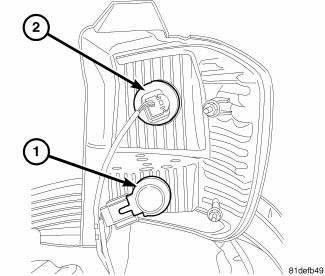
Fig. 30: Tail/Stop/Rear Side Marker And Turn Signal
NOTE: The outer rear lamp unit contains two bulbs. They are the tail/stop/rear side marker (1) and the turn signal (2). The service procedures for each bulb are the same, only the bulb sizes and types may differ.
1. Align the base of the bulb with the appropriate bulb socket (1 or 2).
2. Push the bulb straight into the socket until the base is firmly seated.
3. Align the socket and bulb with the keyed opening on the back of the outer rear lamp unit housing.
4. Insert the socket and bulb into the housing until the socket is firmly seated.
5. Rotate the socket clockwise about 30 degrees to lock it into place.
6. Reinstall the outer rear lamp unit.
7. Reconnect the battery negative cable.
INNER LAMP
CAUTION: Always use the correct bulb size and type for replacement. An incorrect bulb size or type may overheat and cause damage to the lamp, the socket or the lamp wiring.
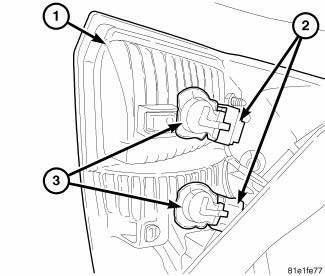
Fig. 31: Bulb Socket On Back Of Lamp Housing
NOTE: The inner rear lamp unit contains two bulbs. The upper socket contains the tail lamp bulb, while the lower socket contains the backup lamp bulb. The service procedures for each bulb are the same, only the bulb sizes and types may differ.
1. Align the base of the bulb with the appropriate bulb socket (3).
2. Push the bulb straight into the socket until the base is firmly seated.
3. Align the socket and bulb with the keyed opening on the back of the inner rear lamp unit housing.
4. Insert the socket and bulb into the housing until the socket is firmly seated.
5. Rotate the socket clockwise about 30 degrees to lock it into place.
6. Reinstall the inner rear lamp unit.
7. Reconnect the battery negative cable.
LAMP
Each rear lamp unit for this vehicle consists of two pieces. An outer rear lamp unit that is secured at the rear of each quarter panel includes bulbs for the park (or tail) lamps, the brake (or stop) lamps and the turn signal lamps. An inner rear lamp is secured on each outboard side of the liftgate outer panel adjacent to the outer lamp and also includes a bulb for the park (or tail) lamps as well as a bulb for the backup (or reverse) lamps. These lamp units are serviced individually as follows.
OUTER
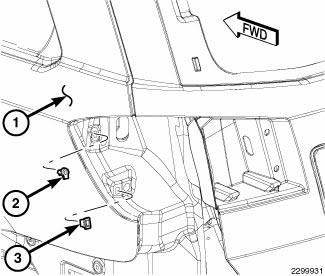
Fig. 32: Plastic Grommets
1. Check to be certain that the two plastic grommets (2 and 3) are in good condition and properly installed in the outboard side of the lamp opening of the body sheet metal (1).
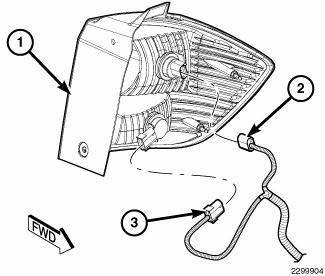
Fig. 33: Body Wire Harness Connectors
2. Position the outer rear lamp unit (1) to the lamp opening of the body sheet metal.
3. Reconnect the two body wire harness connectors (2 and 3) to the bulb socket connector receptacles on the back of the lamp housing.
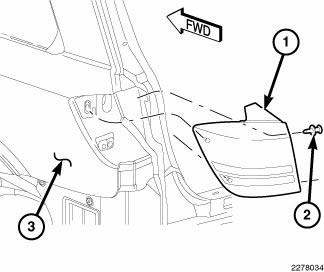
Fig. 34: Outer Rear Lamp Unit
4. Align the two locating pins on the back of the lamp housing (1) with the plastic grommets in the lamp opening of the body sheet metal (3).
5. Using hand pressure, push firmly and evenly on the outboard top and bottom of the lamp until both alignment pins snap into the grommets.
6. Reinstall the two push pin fasteners (2) that secure the inboard side of the outer rear lamp unit to the side jamb of the liftgate opening.
7. Reconnect the battery negative cable.
INNER
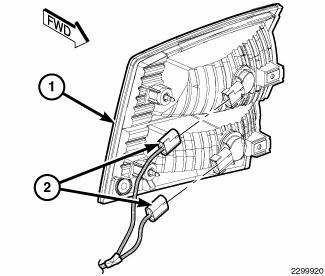
Fig. 35: Liftgate Wire Harness Connectors
1. Check to be certain that the two plastic grommets are in good condition and properly installed on the inboard side of the liftgate lamp opening. If a grommet is removed, it must be replaced with a new unit.
2. Check to be certain that the two U-nuts are in good condition and properly installed on the outboard side of the inner rear lamp unit (1).
3. Position the lamp to the liftgate lamp opening.
4. Reconnect the two liftgate wire harness connectors (2) to the bulb socket connector receptacles on the back of the lamp housing.
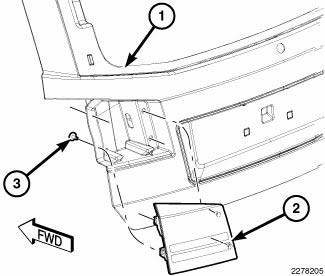
Fig. 36: Inner Rear Lamp Unit
5. Align the two locating pins on the back of the lamp housing (2) with the plastic grommets in the liftgate (1) lamp opening.
6. Using hand pressure, push firmly and evenly on the inboard top and bottom of the lamp until both alignment pins snap into the grommets.
7. Install and tighten the two screws (3) that secure the outboard side of the inner rear lamp unit to the liftgate lamp opening. Tighten the screws to 1.5 N.m (15 in. lbs.).
8. Reconnect the battery negative cable.
 Removal
Removal
BULB
Each rear lamp unit for this vehicle consists of two pieces. An outer rear
lamp unit that is secured at the rear of
each quarter panel includes bulbs for the park (or tail) lamps, the brake ( ...
 Motor, headlamp leveling, export
Motor, headlamp leveling, export
DESCRIPTION
Fig. 37: Headlamp Leveling Motor
The headlamp leveling motor (1) is located on the rear surface of each front
lamp unit on vehicles equipped
with the headlamp leveling system, which ...
See also:
Camshaft, engine
DESCRIPTION
Fig. 108: Camshaft & Valvetrain Components
- CAMSHAFT BEARING CAP - INTAKE
- CAMSHAFT BEARING CAP - EXHAUST
- CAMSHAFT - EXHAUST
- ROCKER ARM
- HYDRAULIC LIFTER
- CYLI ...
Standard procedure
SPIRAL CELL BATTERY CHARGING
WARNING: Never exceed 14.4 volts when charging a spiral cell
battery. Personal
injury and/or battery damage may result.
Vehicles equipped with a diese ...
Operation
Following are paragraphs that briefly describe the operation of each of the
major exterior lighting systems. The
lamps and the hard wired circuits between components related to the exterior
light ...
